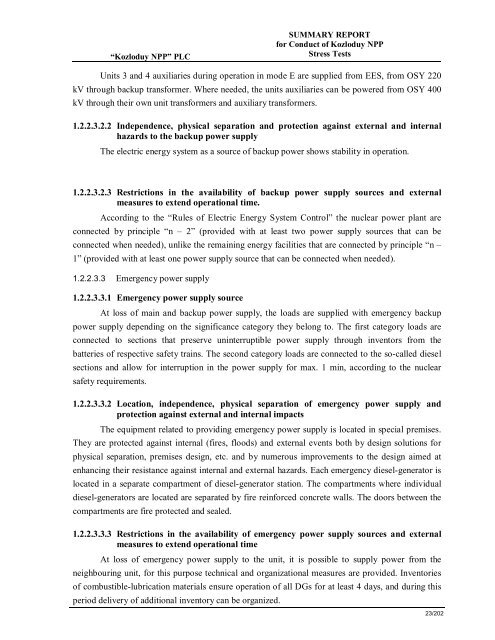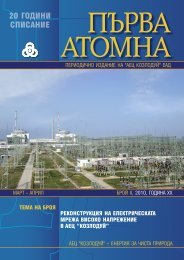Summary Report for Conduct of Kozloduy NPP Stress Tests
Summary Report for Conduct of Kozloduy NPP Stress Tests
Summary Report for Conduct of Kozloduy NPP Stress Tests
You also want an ePaper? Increase the reach of your titles
YUMPU automatically turns print PDFs into web optimized ePapers that Google loves.
“<strong>Kozloduy</strong> <strong>NPP</strong>” PLC<br />
SUMMARY REPORT<br />
<strong>for</strong> <strong>Conduct</strong> <strong>of</strong> <strong>Kozloduy</strong> <strong>NPP</strong><br />
<strong>Stress</strong> <strong>Tests</strong><br />
Units 3 and 4 auxiliaries during operation in mode E are supplied from EES, from OSY 220<br />
kV through backup trans<strong>for</strong>mer. Where needed, the units auxiliaries can be powered from OSY 400<br />
kV through their own unit trans<strong>for</strong>mers and auxiliary trans<strong>for</strong>mers.<br />
1.2.2.3.2.2 Independence, physical separation and protection against external and internal<br />
hazards to the backup power supply<br />
The electric energy system as a source <strong>of</strong> backup power shows stability in operation.<br />
1.2.2.3.2.3 Restrictions in the availability <strong>of</strong> backup power supply sources and external<br />
measures to extend operational time.<br />
According to the “Rules <strong>of</strong> Electric Energy System Control” the nuclear power plant are<br />
connected by principle “n – 2” (provided with at least two power supply sources that can be<br />
connected when needed), unlike the remaining energy facilities that are connected by principle “n –<br />
1” (provided with at least one power supply source that can be connected when needed).<br />
1.2.2.3.3 Emergency power supply<br />
1.2.2.3.3.1 Emergency power supply source<br />
At loss <strong>of</strong> main and backup power supply, the loads are supplied with emergency backup<br />
power supply depending on the significance category they belong to. The first category loads are<br />
connected to sections that preserve uninterruptible power supply through inventors from the<br />
batteries <strong>of</strong> respective safety trains. The second category loads are connected to the so-called diesel<br />
sections and allow <strong>for</strong> interruption in the power supply <strong>for</strong> max. 1 min, according to the nuclear<br />
safety requirements.<br />
1.2.2.3.3.2 Location, independence, physical separation <strong>of</strong> emergency power supply and<br />
protection against external and internal impacts<br />
The equipment related to providing emergency power supply is located in special premises.<br />
They are protected against internal (fires, floods) and external events both by design solutions <strong>for</strong><br />
physical separation, premises design, etc. and by numerous improvements to the design aimed at<br />
enhancing their resistance against internal and external hazards. Each emergency diesel-generator is<br />
located in a separate compartment <strong>of</strong> diesel-generator station. The compartments where individual<br />
diesel-generators are located are separated by fire rein<strong>for</strong>ced concrete walls. The doors between the<br />
compartments are fire protected and sealed.<br />
1.2.2.3.3.3 Restrictions in the availability <strong>of</strong> emergency power supply sources and external<br />
measures to extend operational time<br />
At loss <strong>of</strong> emergency power supply to the unit, it is possible to supply power from the<br />
neighbouring unit, <strong>for</strong> this purpose technical and organizational measures are provided. Inventories<br />
<strong>of</strong> combustible-lubrication materials ensure operation <strong>of</strong> all DGs <strong>for</strong> at least 4 days, and during this<br />
period delivery <strong>of</strong> additional inventory can be organized.<br />
23/202

















